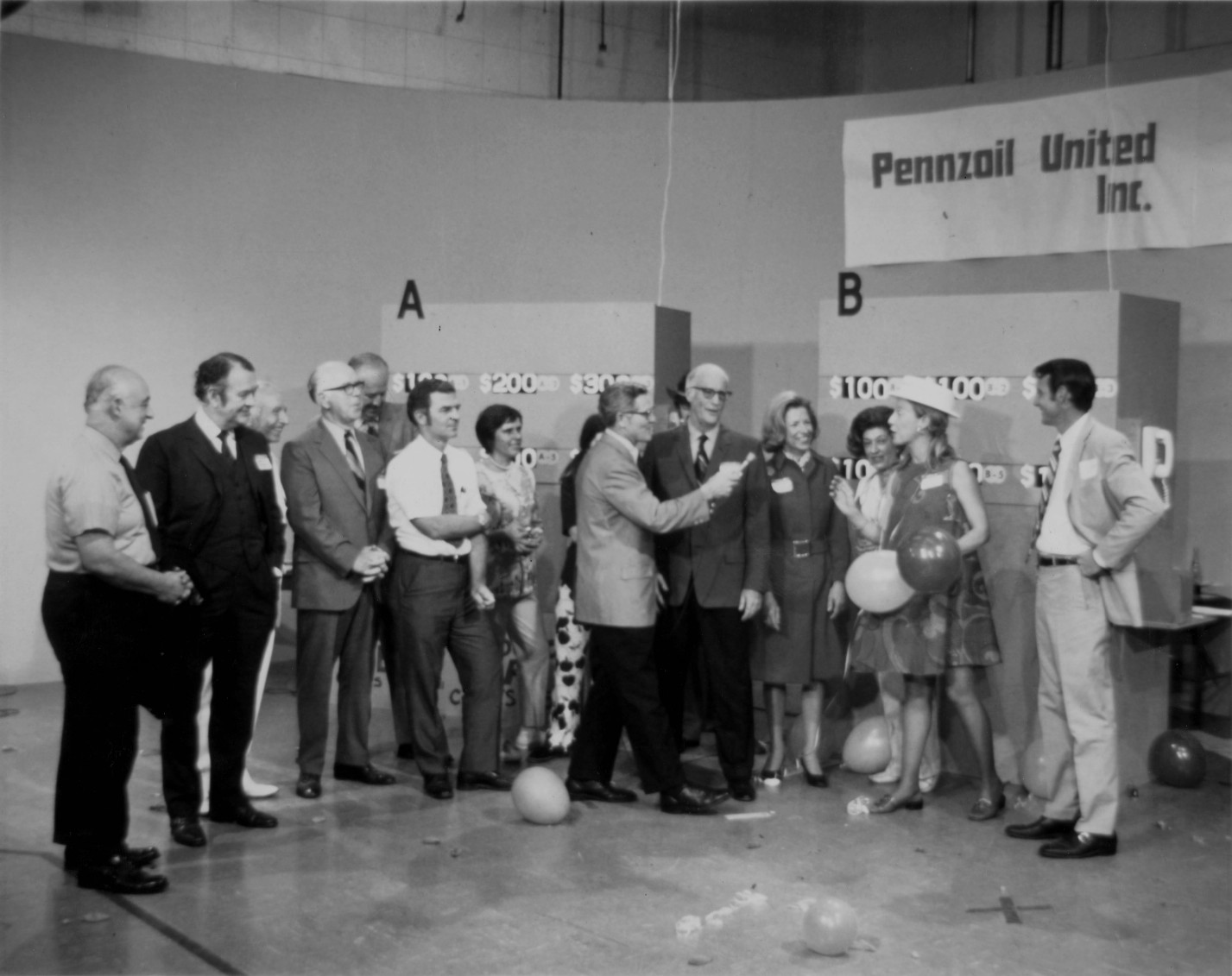|
BandaOke! Rock 'N Roll To Millions
''BandaOke! Rock 'N Roll to Millions'' is a Philippine television game show by GMA Network. Hosted by Jaya (singer), Jaya and Allan K., it premiered on October 25, 2009. The show concluded on March 21, 2010 with a total of 22 episodes. It was replaced by ''Claudine (TV program), Claudine'' in its timeslot. Cast ;Hosts * Jaya (singer), Jaya * Allan K. ;Band * Frencheska Farr * Geoff Taylor (singer), Geoff Taylor * Jay Perillo * Tim Mallilin - bass * Weckl Mercado - lead guitar * Michael Gemina - drums * Ivan Espinosa - piano * Iean Iñigo - 2nd keyboard Format BandaOke opens with a grand number showcasing the two game masters jamming with a band specially formed for the show. The number leads to three rounds of live band-videoke singing showdown between two teams of celebrity players, each headed by a celebrity bandmaster. Members of the winning team of rounds 1 to 3 then face off in the One-on-One-on-One round to determine the jackpot player. The jackpot player advances to on ... [...More Info...] [...Related Items...] OR: [Wikipedia] [Google] [Baidu] |
Game Show
A game show is a genre of broadcast viewing entertainment (radio, television, internet, stage or other) where contestants compete for a reward. These programs can either be participatory or demonstrative and are typically directed by a host, sharing the rules of the program as well as commentating and narrating where necessary. The history of game shows dates back to the invention of television as a medium. On most game shows, contestants either have to answer questions or solve puzzles, typically to win either money or prizes. Game shows often reward players with prizes such as cash, trips and goods and services provided by the show's sponsor. History 1930s–1950s Game shows began to appear on radio and television in the late 1930s. The first television game show, ''Spelling Bee'', as well as the first radio game show, '' Information Please'', were both broadcast in 1938; the first major success in the game show genre was '' Dr. I.Q.'', a radio quiz show that began in 193 ... [...More Info...] [...Related Items...] OR: [Wikipedia] [Google] [Baidu] |
Claudine (TV Program)
''Claudine'' is a 2010 Philippine television drama anthology broadcast by GMA Network. Starring Claudine Barretto, it premiered on April 10, 2010 replacing ''BandaOke! Rock 'N Roll to Millions''. The show concluded on August 7, 2010 with a total of 18 episodes. Episodes Ratings According to AGB Nielsen Philippines AGB Nielsen Media Research Philippines, commonly called AGB Nielsen, is a market research firm in the Philippines specializing in broadcast media. AGB Nielsen conducts audience measurement of television ratings for certain areas in the Philipp ...' Mega Manila household television ratings, the pilot episode of ''Claudine'' earned a 16.6% rating. While the final episode scored a 9.2% rating in Mega Manila People/Individual television ratings. References External links * {{IMDb title, 1634546 2010 Philippine television series debuts 2010 Philippine television series endings Filipino-language television shows GMA Network original programming Philippine ant ... [...More Info...] [...Related Items...] OR: [Wikipedia] [Google] [Baidu] |
Filipino-language Television Shows
Filipino (; , ) is an Austronesian language. It is the national language ( / ) of the Philippines, and one of the two official languages of the country, with English. It is a standardized variety of Tagalog based on the native dialect, spoken and written, in Metro Manila, the National Capital Region, and in other urban centers of the archipelago. The 1987 Constitution mandates that Filipino be further enriched and developed by the other languages of the Philippines. Filipino is only used as a tertiary language in the Philippine public sphere. Filipino, like other Austronesian languages, commonly uses verb-subject-object order, but can also use subject-verb-object order as well. Filipino follows the trigger system of morphosyntactic alignment that is also common among Austronesian languages. It has head-initial directionality. It is an agglutinative language but can also display inflection. It is not a tonal language and can be considered a pitch-accent language and a ... [...More Info...] [...Related Items...] OR: [Wikipedia] [Google] [Baidu] |
2010 Philippine Television Series Endings
1 (one, unit, unity) is a number representing a single or the only entity. 1 is also a numerical digit and represents a single unit of counting or measurement. For example, a line segment of ''unit length'' is a line segment of length 1. In conventions of sign where zero is considered neither positive nor negative, 1 is the first and smallest positive integer. It is also sometimes considered the first of the infinite sequence of natural numbers, followed by 2, although by other definitions 1 is the second natural number, following 0. The fundamental mathematical property of 1 is to be a multiplicative identity, meaning that any number multiplied by 1 equals the same number. Most if not all properties of 1 can be deduced from this. In advanced mathematics, a multiplicative identity is often denoted 1, even if it is not a number. 1 is by convention not considered a prime number; this was not universally accepted until the mid-20th century. Additionally, 1 is th ... [...More Info...] [...Related Items...] OR: [Wikipedia] [Google] [Baidu] |
2009 Philippine Television Series Debuts
9 (nine) is the natural number following and preceding . Evolution of the Arabic digit In the beginning, various Indians wrote a digit 9 similar in shape to the modern closing question mark without the bottom dot. The Kshatrapa, Andhra and Gupta started curving the bottom vertical line coming up with a -look-alike. The Nagari continued the bottom stroke to make a circle and enclose the 3-look-alike, in much the same way that the sign @ encircles a lowercase ''a''. As time went on, the enclosing circle became bigger and its line continued beyond the circle downwards, as the 3-look-alike became smaller. Soon, all that was left of the 3-look-alike was a squiggle. The Arabs simply connected that squiggle to the downward stroke at the middle and subsequent European change was purely cosmetic. While the shape of the glyph for the digit 9 has an ascender in most modern typefaces, in typefaces with text figures the character usually has a descender, as, for example, in . The mo ... [...More Info...] [...Related Items...] OR: [Wikipedia] [Google] [Baidu] |
AGB Nielsen Philippines
AGB Nielsen Media Research Philippines, commonly called AGB Nielsen, is a market research firm in the Philippines specializing in broadcast media. AGB Nielsen conducts audience measurement of television ratings for certain areas in the Philippines, most notably in urban areas. As of 2013, AGB Nielsen uses a panel size of 1,980 households based solely in urban areas that represent 57 percent of the total Philippine TV viewing population. History AGB Nielsen was created by the merger of the Audits of Great Britain-Philippines (established in 1999) and Nielsen Media Research (established in 1992) in 2005 as a subsidiary of AGB Nielsen Media Research, a joint venture formed by the AGB Group & the TAM business of The Nielsen Company in March 2005.Introduction [...More Info...] [...Related Items...] OR: [Wikipedia] [Google] [Baidu] |
Geoff Taylor (singer)
Geoff Taylor (born May 26, 1986) is a Filipino singer, model and actor. He was a former finalist of '' Pinoy Dream Academy: Season 1'' before becoming the grand winner of the '' Are You the Next Big Star?'' together with Frencheska Farr as the female grand winner. Early life and career Taylor was born in Olongapo City. His father is of American descent while his mother is a pure Filipina. Before named as the ''Next Male Big Star'' of the talent search, '' Are You the Next Big Star?'', he was one of the contestants of ABS-CBN's '' Pinoy Dream Academy: Season 1'' where he was voted off early. Taylor was also a model from Cagayan Valley. After winning ''Are You the Next Big Star?'', he started in various television guestings and shows together with his co-winner, Frencheska Farr. They guested at the ''christmaserye'' of GMA Network, ''Sana Ngayong Pasko''. Taylor and Farr was also included in the recently concluded ''SOP Fully Charged'' and '' BandaOke'' wherein they were includ ... [...More Info...] [...Related Items...] OR: [Wikipedia] [Google] [Baidu] |
Frencheska Farr
Marie Frencheska Mae Tobias Farr-Jose (born September 9, 1992) is a Filipino-British singer, model and actress. She was the Are You the Next Big Star? grand champion along with Geoff Taylor. Early life and career Farr was born in Pasay City, Philippines. She graduated from St. Paul College of Parañaque. Her father is of British descent. She was named the ''Next Female Big Star'' along with Geoff Taylor as the ''Next Male Big Star'' on the television show "Are You the Next Big Star?". Along with winning the contest, they each received one million pesos (P1,000,000), a condominium unit from Avida, a management contract from GMA Artist Center and a recording contract from GMA Records. After winning ''Are You the Next Big Star?'', she started in various television guestings and shows. She guested at the ''christmaserye'' of GMA Network, Sana Ngayong Pasko. She was also included in the defunct SOP. She also became a part of the BandaOke wherein she was included in the ''BandaO ... [...More Info...] [...Related Items...] OR: [Wikipedia] [Google] [Baidu] |
Game Show
A game show is a genre of broadcast viewing entertainment (radio, television, internet, stage or other) where contestants compete for a reward. These programs can either be participatory or demonstrative and are typically directed by a host, sharing the rules of the program as well as commentating and narrating where necessary. The history of game shows dates back to the invention of television as a medium. On most game shows, contestants either have to answer questions or solve puzzles, typically to win either money or prizes. Game shows often reward players with prizes such as cash, trips and goods and services provided by the show's sponsor. History 1930s–1950s Game shows began to appear on radio and television in the late 1930s. The first television game show, ''Spelling Bee'', as well as the first radio game show, '' Information Please'', were both broadcast in 1938; the first major success in the game show genre was '' Dr. I.Q.'', a radio quiz show that began in 193 ... [...More Info...] [...Related Items...] OR: [Wikipedia] [Google] [Baidu] |
SDTV
Standard-definition television (SDTV, SD, often shortened to standard definition) is a television system which uses a resolution that is not considered to be either high or enhanced definition. "Standard" refers to it being the prevailing specification for broadcast (and later, cable) television in the mid- to late-20th century, and compatible with legacy analog broadcast systems. The two common SDTV signal types are 576i, with 576 interlaced lines of resolution, derived from the European-developed PAL and SECAM systems, and 480i based on the American NTSC system. Common SDTV refresh rates are 25, 29.97 and 30 frames per second. Both systems use a 4:3 aspect ratio. Standards that support digital SDTV broadcast include DVB, ATSC, and ISDB. The last two were originally developed for HDTV, but are also used for their ability to deliver multiple SD video and audio streams via multiplexing. In North America, digital SDTV is broadcast in the same 4:3 aspect ratio as ... [...More Info...] [...Related Items...] OR: [Wikipedia] [Google] [Baidu] |
Philippine Television
Television in the Philippines was introduced in October 1953 upon the first commercial broadcast made by Alto Broadcasting System (now ABS-CBN), making the Philippines the first Southeast Asian country and the second in Asia to do so. Even before that, during the late 1940s, a number of academic experiments had been done and replicated by Filipino engineers and students. From 1975 to 1978, the Sinag Awards were given by the Philippine Academy for Television Arts and Sciences (PATAS). The Star Awards for Television are the oldest existing television awards in the country; they are handed out annually by the Philippine Movie Press Club and are voted by the press. The Philippines has no public broadcasting television network. History The early years (1946–1959) James Lindenberg, an American engineer dubbed the "father of Philippine television," began assembling transmitters and established Bolinao Electronics Corporation (BEC) on June 13, 1946. The company was named after ... [...More Info...] [...Related Items...] OR: [Wikipedia] [Google] [Baidu] |
Multiple-camera Setup
The multiple-camera setup, multiple-camera mode of production, multi-camera or simply multicam is a method of filmmaking and video production. Several cameras—either film or professional video cameras—are employed on the set and simultaneously record or broadcast a scene. It is often contrasted with a single-camera setup, which uses one camera. Description Generally, the two outer cameras shoot close-up shots or "crosses" of the two most active characters on the set at any given time, while the central camera or cameras shoot a wider master shot to capture the overall action and establish the geography of the room. In this way, multiple shots are obtained in a single take without having to start and stop the action. This is more efficient for programs that are to be shown a short time after being shot as it reduces the time spent in film or video editing. It is also a virtual necessity for regular, high-output shows like daily soap operas. Apart from saving editing ... [...More Info...] [...Related Items...] OR: [Wikipedia] [Google] [Baidu] |




.jpg)